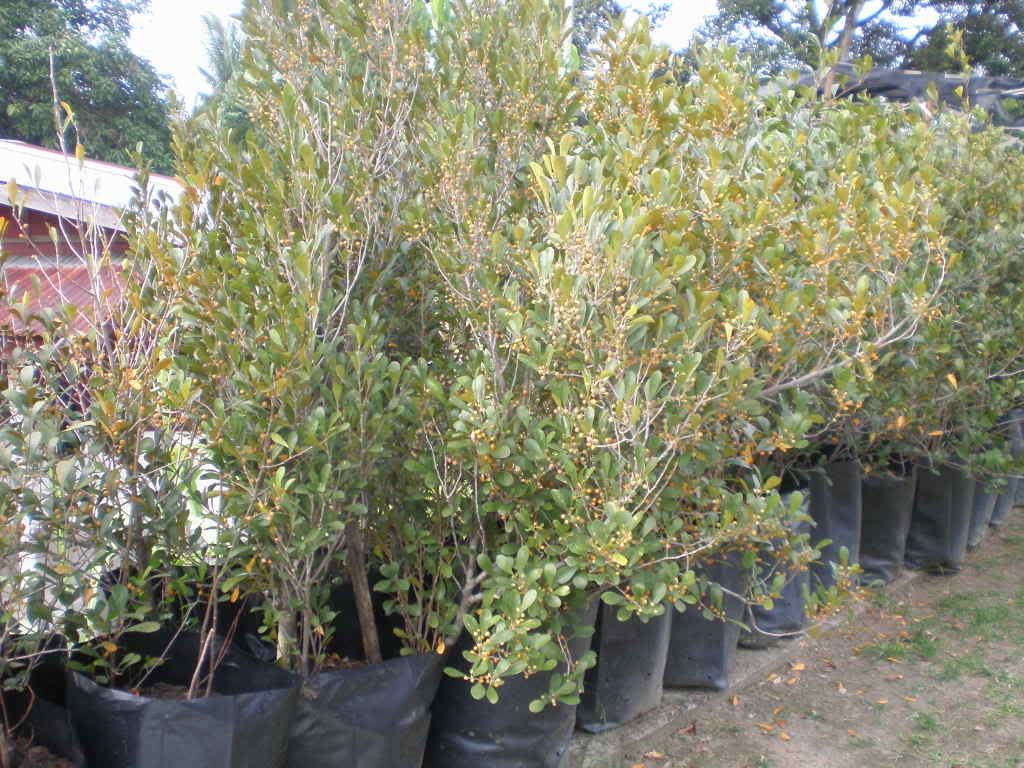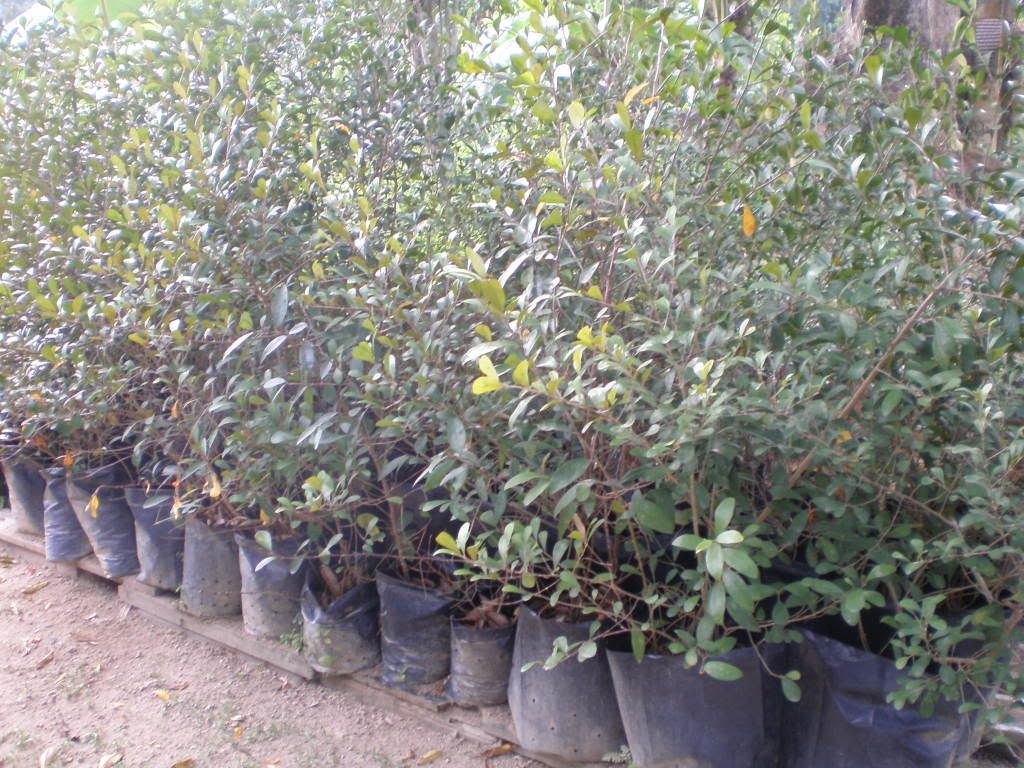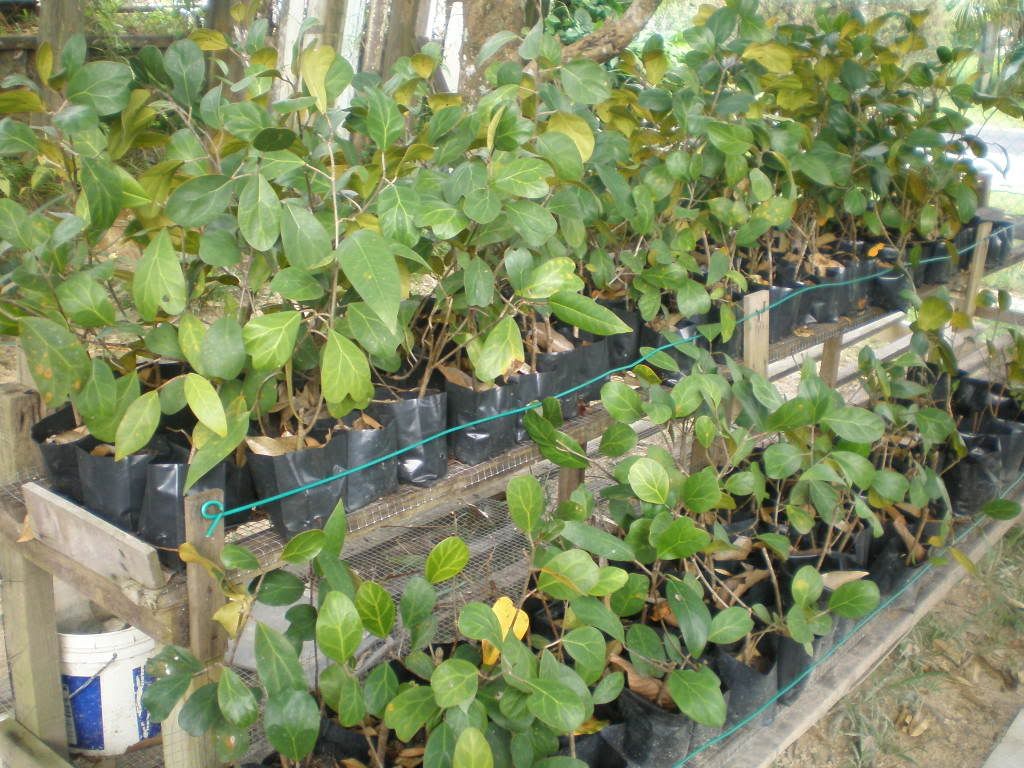BAHAN:
1. Tanah 2 tan
2. Fiber Kelapa Sawit 1/2 tan
3. Sekam padi yang sudah dibakar 1/3 tan
gaulkan bahan-bahan 1-3 sehingga sebati dan biarkan selama 3 hari
siram bahan yang sudah digaul tadi dengan EM( Effective Microrganisma) yang telah diperkayakan EM1.
Setelah itu bahan media pun sudah siap untuk dimasukkan kedalam polybag
Monday, March 31, 2008
MEDIA TANAMAN BENIH MAS COTEK
Saturday, March 29, 2008
Report dari United States Geological Survey
Mistletoe fig
Moraceae
Forest Starr, Kim Starr, and Lloyd Loope
United States Geological Survey--Biological Resources Division
Haleakala Field Station, Maui, Hawai'i
January, 2003
cultivated as other more popular figs, such as F. benjamina or F. elastica, and is known
from just a few plantings. This species is not yet reproducing sexually because each
Ficus species needs a specific pollinator wasp (Agaonidae) in order to reproduce and
spread (Ramirez 1970) and the pollinator wasp for F. deltoidea has not yet been
introduced to Hawai'i. The potential for Ficus species to spread in Hawai'i once their
pollinator wasps are introduced has been demonstrated already and future naturalization
of Ficus species could be prevented by preventing the introduction of pollinator wasps by
adding them to the list of injurious animal species. This would prohibit the wasps from
introduction and help to minimize the chance for this Ficus species to spread. In
addition, F. deltoidea is not widely planted and removal of this species and adding it to
the noxious weed list would also assist in prevention of future spread.
Latin name: Ficus deltoidea Jack (Bailey and Bailey 1976).
Synonyms: Ficus diversifolia Blume (Bailey and Bailey 1976).
Common names: Mistletoe fig, Mistletoe rubber plant (Bailey and Bailey 1976).
Taxonomic notes: The genus Ficus is made up of about 1,000 species from pantropical
and subtropical origins (Wagner et al. 1999). Plants in the genus are all woody, ranging
from trees and shrubs to climbers (Neal 1965).
Nomenclature: The common name, mistletoe fig, comes from the habit of the plant as
an epiphyte often growing on larger trees. The scientific name, deltoidea, triangularis,
refers to the shape of the leaf.
Related species in Hawai'i: About 60 species of Ficus have been introduced to Hawai'i
for cultivation and reforestation (Wagner et al. 1999).
(5-7 m) tall and 3-10 ft (1-3 m) wide. Leaves broadly spoon-shaped to obovate, leathery,
1 1/2–3 in (4-8 cm) long, bright green above and rust-red to olive brown beneath.
Spherical to round figs, to 1/2 in (1.5 cm)across, ripening from dull yellow to orange and
red, are freely produced in pairs." (Brickell and Zuk 1997). Seeds are minute.
"This large shrub or small tree with aerial roots often begins its life as an epiphyte but is
not a banyan. It grows only 20 feet or so in height and is more often found as a shrub
than a tree, even in nature. Indeed, it is usually seen as a large cascading epiphytic shrub
on large trees, thus one of the common names of mistletoe fig. It is a spreading and
somewhat sprawling shrub with slender zigzagging branches. The bark is gray and what
trunk there is slender and usually leaning. The leaf shape is probably the most variable in
the whole genus and ranges from elliptical or lanceolate to obovate or spatulate, the two
latter shapes being more common than the two former. Only the spatulate-shaped leaf
form is regularly sold and cultivated. The 3-inch-long leaves are dark green thick and
leathery, almost succulent, and the ends of the spatulate-shaped leaves are usually
provided with a shallow notch. The plant loves warmth and humidity, and produces
picturesque aerial roots under such conditions." (Riffle 1998).
to be one of the only Ficus species that will produce fruits when cultivated indoors
(McKenny and Lineberger 2002). It also makes a nice shrub or foreground subject for
larger trees (Riffle 1998). On Maui, it is planted in a few locations as a small shrub. On
Kaua'i, in the Sleeping Giant area, this species is planted along a road fronting a private
property. The hedge is rather large, reaching about 3-4 m in height with long arching
branches that appeared to reach into and climb up other adjacent small trees. This plant
prefers warmth and humidity and produces aerial roots under such conditions (Riffle
1998).
Invasiveness: There was not much literature found about the invasiveness of F.
deltoidea. It is listed in Western Australia's global compendium of weeds (Randall 2002)
as Ficus triangularis, a possible synonym, as a quarantine weed. Currently, this species
is not reproducing sexually in Hawai'i. If the associated pollinator wasp was introduced
and successfully established, this species may begin to spread. Invasive attributes are
likely to be similar to other invasive Ficus species that have had their associated wasps
introduced and are reproducing on their own. These attributes include large seed
production, small fruit and seed size, ample vectors such as fruit eating birds and other
mammals to spread the seeds long distances, ability to germinate and grow as an
epiphyte, sometimes on native host plants, ability to replace desirable vegetation, and
difficulty in controlling epiphytic plants in steep terrain.
Pollination: The fruit (syconium or fig) and reproduction systems of species in the
genus Ficus are unique. Each species of Ficus has an associated species of agaonid wasp
(Hymenoptera: Chalcoidea: Agaonidae). Ficus species can only be pollinated by their
associated agaonid wasps and in turn, the wasps can only lay eggs within their associated
Ficus fruit.
Propagation: Ficus species propagate from seed and many can be propagated from
cuttings. Trees can begin life as epiphytes on other trees.
Dispersal: Plants are initially spread by humans who grow the plant for ornament.
Because the pollinator wasp is not yet present, F. deltoidea seeds are not viable. Other
species of Ficus that do have wasps present are spread by fruit eating birds. Various
birds observed by the authors foraging and roosting in other Ficus trees on Maui include
mynah birds (Acridotheres tristis tristis), blue faced doves (Geopelia striata), lace necked
doves (Streptopelia chinensis), Japanese white-eye (Zosterops japonicus), and house
sparrows (Passer domesticus), though there are probably more. Other animals, such as
pigs, rodents, parrots, and monkeys may be capable of spreading fruit.
Pests and diseases: Brickell and Zuk (1997) report that pests and diseases of Ficus
species include: mealybugs, scale insects, spider mites, root knot nematodes, and thrips
occur under most environmental conditions, fungal and bacterial leaf spots, crown gall,
twig dieback, and Southern blight.
and Zuk 1997). Riffle (1998) describes this species as indigenous to the southern
Philippines southward and westward to Southeast Asia, Malaysia, and Indonesia. These
areas are islands located between the Pacific Ocean and the South China sea. The
vegetation type includes tropical rainforest. Average temperature ranges from over 68 F
(20 C) in January to over 86 F (30 C) in July. Average annual rainfall is over 80 in (200
cm) (Hammond 1986).
Global distribution: F. deltoidea is cultivated in various parts of the world and is grown
as a house plant in cooler regions. The following two specimen records were listed in the
Missouri Botanical Garden (2002) specimen database: USA, Florida, Dade, Fairchild
Tropical Garden, 5.5 m (18 ft), 25.37.00N 080.32.00W; and Malaysia, Selangor, 880-900
m (2,887-2,953 ft), 03.58N 101.38E.
State of Hawai'i distribution: The state wide distribution is not certain. Plants are
capable of growing as epiphytes (Brickell and Zuk 1997), however, in Hawai'i, it has
only been observed as planted in the ground on the islands of Kaua'i and Maui. On
Kaua'i, this plant was observed in a mixed planting in the Sleeping Giant residential area.
The plants ran along the front of a private property in a scrubby border probably planted
as a wind break or privacy screen. The plants had long arching branches that were
climbing in surrounding allspice (Pimenta dioica) and Surinam cherry (Eugenia
uniflora). Fruits were present and no seeds or wasps were observed, nor any
reproduction of the plant. The plants were robust in appearance and reached heights of 3-
4 m, much larger than previously observed plantings on Maui.
Island of Maui distribution: On Maui, few locations of cultivated F. deltoidea have
been observed. One is located at the Makawao Elementary school as a small shrub
grown in a hedge with other plants. The shrub is small (about 1 x 1 m) and sheared.
Fruits have been observed, though no wasps or sexual reproduction have ever been
observed. The other is located in Pukalani and is similar to the planting in Makawao. In
addition, F. deltoidea was recently observed for sale at the Kula Ace Hardware store, so
more locations are likely.
hand.
Chemical control: "Fig trees are particularly sensitive to triclopyr herbicides as a basal
or cut-stump treatment. Trees found growing on concrete or rock structures should be
treated with herbicide while young to avoid costly structural damage. Use extreme
caution when applying herbicide to figs growing as epiphytes to ensure that the poison
does not contact the host tree. When exotic figs germinate high in the branches of large
trees in natural forest communities, it may be extraordinarily difficult to get close enough
to the fig to treat it." (Hammer 1996).
Biological control: Nadel et al. (1991) report several pests that could be looked at for
biological control potential including various ants which were seen carrying off pollinator
wasps from Ficus fruits, Hymenoptera and mites that may be parasites of the pollinator
wasps, and staphylinids which were seen entering Ficus fruits and eating the pollinator
wasps.
Cultural control: The pollinator wasps (Agaonidae) should be prevented from entering
Hawai'i by adding them to the Department of Agriculture's injurious animals list in order
to prevent spread of F. deltoidea. Ficus species could be added to the Department of
Agriculture's noxious weed list. Alternative native plants and non-invasive non-natives
other than Ficus species can be used in landscaping.
Noxious weed acts: None.
has not yet been introduced. It is sparingly cultivated in Hawai'i and only a few
specimens have been observed on the islands of Kaua'i and Maui. Though this species is
not widely known as invasive elsewhere and is not widely planted in Hawai'i, if the
associated pollinator wasp was introduced, there would be the potential for it to become
naturalized. Ficus wasps should be placed on the Department of Agriculture's injurious
animals list to prevent further introduction of associated pollinator wasps to prevent the
spread of this and other species of Ficus in Hawai'i.
NY.
Brickell, C. and J. D. Zuk. 1997. The American Horticultural Society A-Z Encyclopedia
of Garden Plants. DK Publishing, Inc., NY.
Hammer, R.L. In: Randall, J.M. and J. Marinelli, ed. 1996. Invasive Plants: Weeds of
the Global Garden. Brooklyn Botanic Garden Handbook 149. p. 33-34.
Hammond Incorporated. 1986. Hammond Citation World Atlas. Hammond
Incorporated, Maplewood, NJ.
McKenny, C. and D. Lineberger. 2002. Outstanding Interiorscape Plants. Interior Plants
Database, Texas A&M University. Available: http://aggie-horticulture.tamu.edu/-
interiorscape/ficusdiv.html (Accessed: March 7, 2002).
Missouri Botanical Garden. 2002. W3TROPICOS: Specimen database. Available:
http://mobot.mobot.org/cgi_bin/search_vast (Accessed: March 30, 2002).
Nadel, H., J.H. Frank, and R.J. Knight. 1992. Escapees and accomplices: The
naturalization of exotic Ficus and their associated faunas in Florida. Florida
Entomologist 75(1):29-38.
Neal, M.C. 1965. In Gardens of Hawai'i. Bernice P. Bishop Museum, Special
Publication 40, Honolulu, HI.
Oppenheimer, H.L. and R.T. Bartlett. 2000. New plant records from Maui, O'ahu, and
Hawai'i Islands. Bishop Mus. Occas. Pap. 64(1):1-10.
Ramirez, B.W. 1970. Host specificity of fig wasps (Agaonidae). Evol. 24: 680-691.
Randall, R. 2002. The Global Compendium of Weeds: Ficus triangularis. Department
of Agriculture, Western Australia. Available: http://www.hear.org/gcw/htmll/-
autogend/species/8379.HTM (Accessed: March 7, 2002).
Riffle, R.L. 1998. The Tropical Look. Timber Press, Inc., Portland, OR.
Wagner, W.L., D.R. Herbst, and S.H. Sohmer. 1999. Manual of the Flowering Plants of
Hawai'i. 2 vols. Bishop Museum Special Publication 83, University of Hawai'i and
Bishop Museum Press, Honolulu, HI.
Tuesday, March 25, 2008
HERBAL & NATURAL PRODUCT EXPO 2008
 Asia Pacific Natural Products Expo (NATPRO) was specifically designed to be the ultimate sourcing showcase for both suppliers and buyers of herbal and natural products. The 5th Asia Pacific Natural Products Expo 2008 (NATPRO 2008) offers a perfect platform for maximizing business opportunities throughout the Asia Pacific region. The Expo is absolutely the right choice to achieve your business plan.
Asia Pacific Natural Products Expo (NATPRO) was specifically designed to be the ultimate sourcing showcase for both suppliers and buyers of herbal and natural products. The 5th Asia Pacific Natural Products Expo 2008 (NATPRO 2008) offers a perfect platform for maximizing business opportunities throughout the Asia Pacific region. The Expo is absolutely the right choice to achieve your business plan.
![]() For those from outside Asia who are natural product manufacturers, marketers or buyers, priceless access to exclusive raw materials and expertise that have stood the test of time.
For those from outside Asia who are natural product manufacturers, marketers or buyers, priceless access to exclusive raw materials and expertise that have stood the test of time.
![]() For Asian farmers, manufacturers, researchers and marketers, an unparalleled opportunity to showcase to the rest of the world the efficacy and reliability of their indigenous products and expertise, and to expand international market boundaries.
For Asian farmers, manufacturers, researchers and marketers, an unparalleled opportunity to showcase to the rest of the world the efficacy and reliability of their indigenous products and expertise, and to expand international market boundaries.
![]() For all involved in the herbal and natural products industry, an excellent opportunity to network and share business wisdom and foresight.
For all involved in the herbal and natural products industry, an excellent opportunity to network and share business wisdom and foresight.
Monday, March 24, 2008
BENIH BETINA TELINGA GAJAH
Benih ini baru sampai ke tapak semaian di Lukut, Port Dickson. Skarang sedang mencari pembantu untuk mengisi media ke dalam polybag.
Friday, March 21, 2008
PRODUK DARIPADA HERBA MAS COTEK
(RM10.00/PAKET)
Berikut ini adalah produk siap yg ada kami jual. Produk ini kami perolehi dengan 2 cara. Pertama dengan belian tunai dan kedua dengan sistem barter, di mana daun mas cotek kami tukarkan dengan produk siap yang ada di kilang memproses mas cotek di Ampang Tinggi, Kuala Pilah, Negeri Sembilan.
Projek Semaian Disekeliling Rumah
Projek ini telah dijalankan bermula pada penghujung tahun 2006. Melihatkan kemampuan herba ini bakal meletup dipasaran tempatan dan antarabangsa, maka bermula projek semaian dan pengumpulan variasi herba mas cotek ini dirumah. Disamping mengkaji kaedah penanaman dan permasalahan berkaitan herba ini.
Wednesday, March 19, 2008
Ficus Deltoieda Content - English
Ficus Deltoieda make medical heritage Malay since first. Ficus Deltoieda his botanical name is Mas Cotek really known in Malaysia. Coloured leaf green at the top and golden-hued in the lower part and exist black spot in every branch base this leaf vein. It pay various nutrition to body human body.
Cotek's leaf contains material Flavanoids who act as anti oksidant and anti inflamatori high as guard healthy bloodstream, anti fed up, anti virus, protect heart and estrogenic. In addition, water leaf boiled, fruit, stem and root containing Tannins who act as weak tissue stiffening, dry excess water diarrhoea result and protect tissue damaged result burnt or exzema.
Triterpenoid's content as Expectorant and nutrient absorption yg high from combination leaf to to the root Emas Cotek this will launch digestion. Phenois's content will act as anti fed up and anti septic for practitioner have skin disease. Proanthocyanins's content will protect tissue and flow of blood to the heart, hand, feet and eye. This would control the disease high blood, watery lung and heart.
Khasiat Mas Cotek - BM
Emas Cotek merupakan warisan perubatan Melayu sejak dahulu. Emas Cotek atau nama botaninya adalah Ficus Deltoidea amat dikenali di Malaysia. Daunnya berwarna hijau di bahagian atas dan berwarna keemasan di bahagian bawah serta terdapat bintik hitam disetiap pangkal cabang urat daun ini. Ia memberikan pelbagai khasiat kepada tubuh badan manusia.
Daunnya mengandungi bahan Flavanoid yang bertindak sebagai anti oksidant dan anti inflamatori yang tinggi seperti pengawal aliran darah yang sihat, anti radang, anti virus, melindungi hati dan estrogenik. Di samping itu, air rebusan daun, buah, batang dan akar mengandungi Tannins yang bertindak sebagai penegang tisu yang lemah, mengeringkan lebihan air akibat cirit-birit dan melindungi tisu yang rosak akibat terbakar atau exzema.
Kandungan Triterpenoids seperti Expectorant dan penyerapan nutrien yg tinggi dari gabungan daun hingga ke akar Emas Cotek ini akan melancarkan penghadaman. Kandungan Phenois akan bertindak sebagai anti radang dan anti septik bagi pengamal yang mempunyai penyakit kulit. Kandungan Proanthocyanins akan melindungi tisu dan pengaliran darah pada jantung, tangan, kaki dan mata. Ini akan mengawal penyakit darah tinggi, paru-paru berair dan jantung.
Tuesday, March 18, 2008
BUAH MAS COTEK
Kedua-dua sepesis pokok mas cotek jantan dan betina mempunyai buah. Akan tetapi buah yang ada tidak kesemua mempunyai biji yang boleh dijadikan sebagai biji benih. Di sini dipaparkan jenis/warna buah pokok jantan yang mempunyai biji benih.



Monday, March 10, 2008
gambar benih dan pokok mas cotek yang terbaru pada tahun ini


POKOK-POKOK JANTAN INI BERHARGA RM50-RM75 SETIAP SATU POLYBANG
BENIH BETINA INI BERHARGA RM10-RM15 SETIAP SATU POLYBANG






















